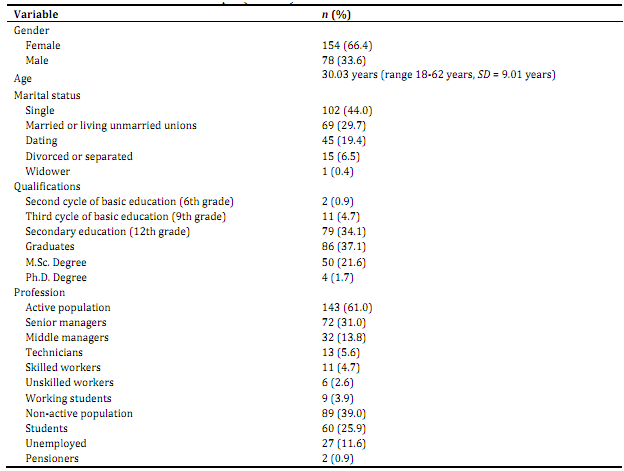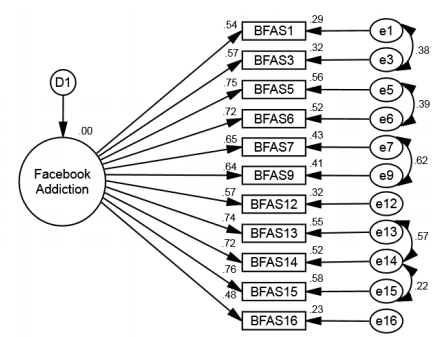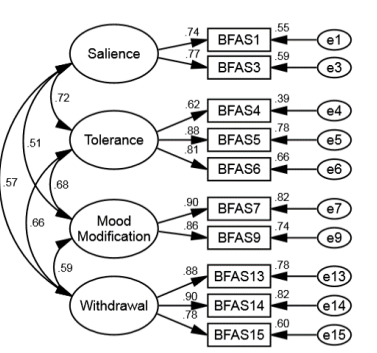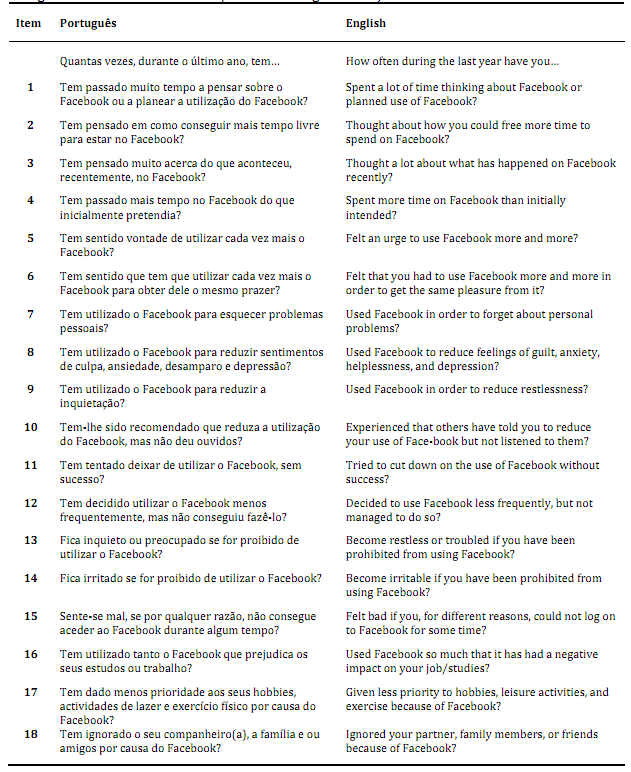According to the American Society of Addiction Medicine (2019), addiction is more than a behavioral disorder. Features of addiction may include aspects of a person’s behaviors, cognitions, emotions, and interactions with others, including a person’s ability to relate to members of their family, to members of their community, to their own psychological state and to things that transcend their daily experience. Following this pathway, the American Psychiatric Association (APA), in the Diagnostic and Statistical Manual of Mental Disorders (American Psychiatry Association, 2013), states that the major change regarding substance abuse, alcohol abuse and dependence disorders has been the removal of the distinction between “abuse” and “dependence.” However, a much more significant change took place by including “gambling disorder” in the addiction chapter as a behavioral addiction. As stated by APA (American Psychiatry Association, 2013, p. 16), this change “reflects the increasing and consistent evidence that some behaviors, such as gambling, activate the brain reward system with effects similar to those of drugs of abuse and that gambling disorder symptoms resemble.
A behavioral addiction such as Social Networking Sites (SNS) addiction may be seen from a biopsychosocial perspective (Andreassen & Pallesen, 2014). “Just like substance-related addictions, it would appear that in some individuals, SNS addiction incorporates the experience of the ‘classic’ addiction symptoms, namely mood modification (i.e., engagement in SNS leads to a favorable change in emotional states), salience (i.e., behavioral, cognitive, and emotional preoccupation with the SNS usage), tolerance (i.e., ever increasing use of SNS over time), withdrawal symptoms (i.e., experiencing unpleasant physical and emotional symptoms when SNS use is restricted or stopped), conflict (i.e., interpersonal and intrapsychic problems ensuing due to SNS usage), and relapse (i.e., addicts quickly revert back to their excessive SNS usage after an abstinence period)” (Griffiths, 2013, p. 1). Thus, from an addiction perspective, SNS addiction has been defined as “being overly concerned about SNS, driven by a strong motivation to log on to or use SNS, and to devote so much time and effort to SNS that it impairs other social activities, studies/job, interpersonal relationships, and/or psychological health and well-being” (Andreassen & Pallesen, 2014, p. 2).
The exponential increase in the use of Facebook (FB) has raised concerns regarding the impact on users’ psychological well-being; for this reason, some authors (Andreassen et al., 2013; Balcerowska et al., 2020) have developed addiction assessment tools. Those tools were primarily designed to assess Internet addiction and, later, they also addressed FB addiction. Because addiction to FB may be a specific form of Internet addiction, or, more specifically, a path toward SNS addiction, and since the use of FB is increasing very rapidly, Andreassen and colleagues (2012) highlighted the need of psychometrically solid procedure for assessing this possible addiction. Therefore, in 2011, the Faculty of Psychology, University of Bergen, in collaboration with the Bergen Clinics Foundation, the same authors developed the Bergen Facebook Addiction Scale (BFAS). The authors began with 18 items and finished the process with 6 items that reflect the aforementioned core elements of addiction, such as salience, mood modification, tolerance, withdrawal, conflict, and relapse (Andreassen et al., 2012). According to the authors, BFAS can facilitate treatment research, clinical assessment and can be used for the estimation of FB addiction prevalence in the general population worldwide (Andreassen & Pallesen, 2014; Marcial, 2013).
There are several different scales that are able to assess FB addition (Balcerowska et al., 2020): The Facebook Intensity Scale (FBI; Ellison et al., 2007); The Facebook Intrusion Questionnaire (FIQ; Elphinston & Noller, 2011), an 11-item unnamed measure of Facebook addiction (Omar et al., 2011); The Facebook Addiction Scale (FAS; Çam & Isbulan, 2012), a 7-item modified version of the Generalized Problematic Internet Use Scale 2 (GPIUS; Caplan, 2010; Lee et al., 2012), a 30-item unnamed measure of FB addiction (Balakrishnan & Shamim, 2013); an 8-item Facebook Addiction Scale (FAS; Koc & Gulyagci, 2013), a 12-item Facebook Addiction Scale (FAS; Hong et al., 2014), and semi-structured interview questions (Zaremohzzabieh et al., 2014). The original Bergen Facebook Addiction Scale with 18 items (BFAS; Andreassen et al., 2012) was used in this study because it can be considered the most complete, since it covers different aspects mentioned in other scales (Ryan et al., 2014). For this reason, the authors' final version (6 items) was not used, but the initial version (18 items). In addition, Pontes et al. (2016) validated the 6-item version of the BFAS for the Portuguese population.
The literature shows that the FB Addiction construct relates to other constructs, namely with psychopathological symptoms (Garcia & Sikström, 2014; Tran, 2012), loneliness (Kim et al., 2009), depression (Becker et al., 2013), anxiety (Becker et al., 2013; Xie & Karan, 2019) and personality (Andreassen et al., 2012; Ryan & Xenos, 2011) in a consistent manner.
Relations between the use of the Internet in general and psychopathology have been found: Kim and colleagues (2009) and Leite et al. (2020) established a relationship between Internet use and loneliness, where loneliness is considered to be simultaneously cause and effect of a problematic Internet use. Nevertheless, Cotten et al. (2013) consider that the use of the Internet may be beneficial for decreasing loneliness and increasing social contact among older adults. Garcia and Sikström (2014) found a relationship between the FB updates and a dark triad of personality (psychopathy, narcissism and Machiavellianism), involving socially malevolent behavior, such as self-promotion, emotional coldness, duplicity and aggressiveness; as well as a relationship between the use of FB and perseverative thinking, exacerbating negative mood and negatively affecting adjustment following a stressful life event (Tran 2012). Ryan and Xenos (2011) found evidence that individuals with greater levels of loneliness tend to be FB non-users. On the other hand, Jelenchick and colleagues (2013) found no relationship between the use of FB and clinical depression. However, Becker and colleagues (2013) stated that increased media multitasking was associated with higher depression and social anxiety symptoms. Finally, Andreassen and colleagues (2012) found a positive correlation between FB addiction, neuroticism and extroversion and a negative correlation between FB addiction and conscientiousness.
In the fourth quarter of 2020, FB registered almost 2.8 billion monthly active users. Since the third quarter of 2012, the number of active FB users has exceeded one billion: the first SNS ever to have reached such a figure (Statista, 2021). Using the same source, in 2021 Portugal had around 8.6 million FB users, making it 39th in the world ranking of the largest SNS users. In Portugal, the age group with the largest presence in Facebook is between 25 and 34 years (23.2 %), followed by users between 35 and 44 years (19.9 %). Regarding the gender of Portuguese FB users, 52 % are male and 48 % female. The numbers help to illustrate the importance of this SNS in Portugal.
The aim of this paper is to adapt an existent FB addiction scale, the original 18-item version of the Bergen Facebook Addiction Scale (BFAS), to assess a sample of the Portuguese population for FB addiction. Therefore, a study for BFAS validation among Portuguese FB users was conducted. It is expected that the validation of this instrument for the Portuguese population will present a good fit. The assessment can facilitate treatment research and clinical assessment, and can also be used to estimate the FB addiction prevalence in the general population. The original BFAS was translated into Portuguese, followed by a back-translation process.
Method
Sample
The original sample comprised 251 respondents, and 19 of them were outliers that were removed. The final sample comprised 232 respondents, most of whom were female. The average age was 30.03 years. Regarding the marital status, the majority were single or married. Concerning qualifications, most had completed secondary education or had graduated. In the professional context, most were active. Table 1 presents the sample sociodemographic characterization.
Measures
The BFAS was designed by Andreassen et al. (2012). It originally included 18 items, three for each of the six core criteria of addiction (i.e., salience, mood modification, tolerance, withdrawal, conflict, and relapse) experienced during the past year. Each item is scored on a five-point Likert scale using anchors of 1: Very rarely to 5: Very often. Higher scores indicate greater FB addiction. The authors found a unifactorial model with 6 items and considered that the factor structure of the scale was good and Cronbach’s alpha coefficient was 0.83. The 3-week test-retest reliability coefficient was 0.82. The scores converged with scores for other scales of FB activity. They were also positively related to neuroticism and extraversion, and negatively related to conscientiousness (Andreassen et al., 2012). However, the six items resulting from the adaptation made by Andreassen and colleagues (2012) seemed insufficient to assess the complexity of the phenomenon of adding to FB (as representative of a social network), because each dimension includes only one item, and so it was decided to use the original version of 18 items.
The Brief Symptom Inventory (BSI) (Derogatis, 1975, 1993), adapted by Canavarro (Canavarro, 1999), is a 53-item self-report inventory in which participants rate the extent to which they have been bothered (0 = "not at all" to 4 = "extremely") in the past week by various symptoms. The BSI has nine subscales designed to assess individual symptom groups: somatization, obsessive-compulsive, interpersonal sensitivity, depression, anxiety, hostility, phobic anxiety, paranoid ideation, and psychoticism. BSI also includes three indices of distress (Global Severity Index, GSI, Positive Symptom Distress Index, PSDI, and Positive Symptom Total, PST). The BSI Cronbach’s alpha coefficient in the current sample is 0.97.
The UCLA Loneliness Scale (Russell et al., 1980), adapted by Neto (1989), is an 18-item scale designed to measure one’s subjective feelings of loneliness as well as feelings of social isolation. Participants rate each item as O (“I often feel this way”), S (“I sometimes feel this way”), R (“I rarely feel this way”) or N (“I never feel this way”). The UCLA Cronbach’s alpha coefficient in the current sample is 0.40.
The Beck Depression Inventory (BDI) is a 21-item, self-report rating inventory that measures characteristic attitudes and symptoms of depression (Beck et al., 1961), adapted by Vaz-Serra and Pio-Abreu (1973). The BDI Cronbach’s alpha coefficient in the current sample is 0.89.
The Zung Self-Rating Anxiety Scale (SAS) is a method of measuring levels of anxiety in patients who have anxiety-related symptoms (Zung, 1971), adapted by Ponciano et al. (1982). The scale focuses on the most common general anxiety disorders: coping with stress typically causes anxiety. The SAS test is self-administered, with each response using a 4-point scale, from ‘none of the time” to “most of the time.” There are 20 questions with 15 increasing anxiety level questions and 5 decreasing anxiety questions. The SAS Cronbach’s alpha coefficient in the current sample is 0.80.
The Freiburg Personality Inventory Revised (FPI-R) (Fahrenberg et al., 1984), adapted by Soares et al. (2005) is a structured, verbal, omnibus measure of personality traits, which was constructed to measure normal personality characteristics. The questionnaire consists of 138 dichotomous items designed to measure 12 personality traits: Life satisfaction; Social orientation; Achievement orientation; Inhibition, Irritability; Aggressiveness; Strain; Somatic complaints; Health concerns; Frankness; Extraversion; and Emotionality. FPI-R objectively describes the manifestation of important dimensions of personality, allowing inter-subject comparison. The FPI-R Cronbach’s alpha coefficient in the current sample is 0.84.
Procedures
A study for the original BFAS adaptation among Portuguese FB users was performed over 4 months in 2018. It is a descriptive and exploratory study. A total of 251 respondents answered a sociodemographic questionnaire and the original version of BFAS (Andreassen et al., 2012) that had been previously translated and back-translated by a group of four psychologists, two of them being native English speakers. Based on an examination of the back-translations, it was concluded that there were no problematic items. The scale was well received and participants did not report any problems in answering the items. The questionnaire and the BFAS were available online and the participants received information through the FB, where a page about the study was created. When accessing the link, the opening page contained the informed consent, which had to be accepted by the participants to continue the survey. Since the respondents could only answer the subsequent question, after having responded to the previous one, the respondents who completed the questionnaire answered all the questions and, therefore, no missing cases exist. The criteria for participation in the study were: to have Portuguese nationality, aged equal to or greater than 18 years and to be a daily FB user.
Statistical analyses
According to Marôco (2010), the sample size is within the required parameters (n = 200 - 400) concerning the use of the Maximum Likelihood (ML) method in SEM. There is no missing data. The confirmatory factor analysis of the uni and multifactorial BFAS structure was performed with IBM SPSS Amos 22 software (SPSS, version 22.0; IBM Corp, 2013). To assess the assumptions required for the structural equations analysis, values of |sk| < 3 and |ku| < 10 were considered (Kline, 2010) in order to verify the items’ normal distribution, where sk is the coefficient of Skewness and ku is the coefficient of Kurtosis. According to Kline (2010), values of |sk| < 3 and |ku| < 10 are acceptable to SEM. To verify the existence of outliers, the Mahalanobis squared distance (p1 and p2 < 0.001) was used (Kline, 2010), where p1 is the probability of any observation exceeding the squared Mahalanobis distance of that observation and p2 is the probability that the largest squared distance of any observation would exceed the Mahalanobis computed distance. To test the items’ multicollinearity, Spearman coefficients were calculated, according to a reference value of 0.80 (Field, 2009). To evaluate the goodness-of-fit of the model to the global correlation frame, CFI and GFI values greater than 0.9 and PCFI and PGFI values higher than 0.6 were considered indicative of a good fit, where GFI is the Goodness-of-Fit Index, PCFI is the Parsimony-adjusted Comparative Fit Index and PGFI is the Parsimony-adjusted Goodness-of-Fit Index, all considered Parsimonious Fit Indices representing adjustments. Values of (2/df = ~2 and RMSEA < 0.08 (with PRMSEA < 0.05, significant) were considered, indicating a good model fit, where (2 is the Chi-squared index, df is the degree of freedom and PRMSEA is the probability of RMSEA. Residuals were also computed, with a SRMR ≤ 0.05, where SRMR is the Standardized Root Mean Square Residual (Schermelleh-Engel et al., 2003). The refinement of the BFAS original model was performed from the values of the Modification Indices (MI), widely used in structural equation modeling, for the Lagrange multipliers (LM), considering that trajectories and/or correlations with LM > 11 (p < 0.001) indicate significant variation in the quality of the model (Marôco, 2010). To assess the parsimony of each model, AIC, BCC and MECVI Indices were considered, where AIC is the Akaike information Criterion, BCC is the Browne-Cudeck criterion and MECVI is the modified ECVI, that is, the Expected Cross-Validation Index. Lower values of the indices indicate a more parsimonious model (Marôco, 2010).
Finally, the reliability of the construct was assessed with the composite reliability and the validity of the construct was assessed with Average Variance Extracted (AVE) (Fornell & Larcker, 1981). The overall reliability of the instrument was assessed by calculating the Cronbach’s alpha coefficient statistics and the construct validity was also confirmed through the convergent validity with the BSI, the UCLA Loneliness Scale, the BDI, the SAS and the FPI-R. All these instruments were previously assessed for the Portuguese population, with confirmed good psychometric qualities, and thus, no translation process was necessary. Spearman’s Correlation coefficient was used to estimate the convergent validity.
Results
BFAS Confirmatory factor analysis
When using the Mahalanobis squared distance (p1 and p2 < 0.001), 19 outliers were found (Kline, 2010), as well as 5 items that remained outside the standard reference (that is |sk| > 3 and |ku| >10) (Kline, 2010). Those 5 items were: item 18 (|sk| = 3.07 and |ku| =9.47), item 17 (|sk| = 3.02 and |ku| = 9.63), item 11 (|sk| = 3.19 and |ku| = 10.10), item 10 (|sk| = 3.43 and |ku| = 11.16) and item 2 (|sk| = 3.61 and |ku| = 14.52). Since the model’s goodness-of-fit would be better without these items (Marôco, 2010), they were excluded from the analysis and the remaining ones meeting sk and ku values within the required standard reference (|sk| < 2.82 and |ku| < 9.47) were kept. The absence of items’ multicollinearity was assessed (0.135 < rsp< 0.808), where rsp is the Spearman correlation coefficient, with the exception of items 13 and 14, correlated with a value of 0.808. Taking into account that the correlation value is very close to the reference value 0.80 (Field, 2009), it was decided to not prematurely exclude items 13 and 14 from the original model (Figure 1). The original BFAS model was tested, following the original unifactorial structure. The model (Figure 1: Model 0), with 18 items, reveals an overall unacceptable fit (Table 2).
Table 2 Confirmatory Factor Analysis: global adjustment indices (n = 232)
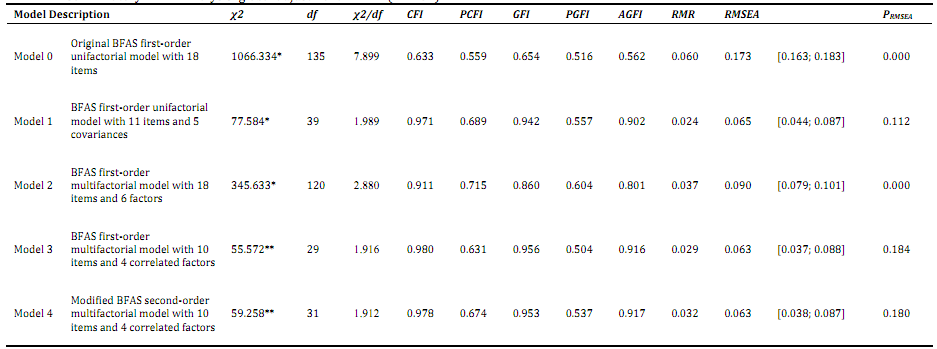
Note: χ2 = Chi-Square Distribution; df = degrees of freedom; CFI = comparative fit index; PCFI = parsimony-adjusted comparative fit index; GFI = goodness-of-fit index; PGFI = parsimony-adjusted goodness-of-fit index; AGFI = adjusted goodness-of-fit index; RMR = root mean square residual; RMSEA = root mean square error of approximation; PRMSEA = probability of RMSEA. *p < 0.001, **p < 0.05.
The second model tested (Figure 2: Model 1) from which 5 items not in the range of normal distribution were eliminated, also shows an overall mediocre fit, according to data presented in Table 2.
However, and after consulting the MI of the Model 1, there are several examples of covariance between the errors of measurement of several items. From a theoretical standpoint, the ones making sense were set out: items 1 and 3 are examples of that, belonging to the same original theoretical element (salience), and the same happens with the remaining set out covariance, as shown in Model 1 (Figure 2). In the same Model 1, the MI suggests that the measurement error associated with item 8 is correlated with the measurement error of several items belonging to other theoretical elements: item 9 (MI = 142.8), item 16 (MI = 21.8), item 14 (MI = 15.5) and item 13 (MI = 14.2). The same applies to the measurement error associated with item 4, which is correlated with item 13 (MI = 12.6) and item 16 (MI = 13.6). In the absence of a theoretical support, it was decided to exclude item 8 and item 4, considered problematic, and thus not to establish the covariance. When redefining the original BFAS model, and although it is necessary to include 5 examples of covariance (these ones with a theoretical support, because they belong to the same originally considered elements), the model presents a globally acceptable fit (Figure 2). As noted, however, measurement errors are not mostly independent but correlated, thus indicating a common source of unexplained variance of the items, which cannot be explained through the only common factor that is present in the model. According to this, it was decided to test a multifactor model, with 6 of the original theoretical elements, now present in Model 2 (Figure 3) as factors (salience, tolerance, mood modification, relapse, withdrawal and conflict).
Aiming to meet the assumptions of normality, the 5 previously referred items - 18, 17, 11, 10 and 2 - were removed from that model, since they presented a non-normal distribution (Figure 4).
With these exclusions, the relapse factor (item 10 and item 11, outside the standard reference) and the conflict factor (item 17 and item 18, outside the standard reference) were removed from the model. This first-order multifactorial model (Figure 4: Model 3) reveals a good overall fit (Schermelleh-Engel et al., 2003), as well as factor loadings above 0.74. On the other hand, the correlational values among the various factors are high and significant (ranging from 0.51 to 0.72) and are still in the theoretically expected directions, indicating that these 4 factors seem to measure a common construct of higher order. Accordingly, analyses were run to test a second-order model that sought to measure the overall construct FB Addiction. This final modified BFAS second-order model (with 10 items and 4 factors) (Figure 5: Model 4) showed a good overall fit (Table 2).
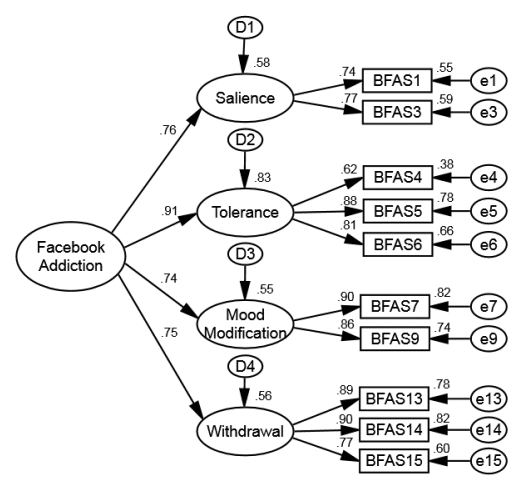
Figure 5 Model 4: Modified BFAS second-order multifactorial model with 10 items and 4 correlated factors.
In this second-order model, all factors are positively correlated with the second-order factor - FB Addiction: salience (r = 0.76, p < 0.001), tolerance (r = 0.91, p < 0.001), mood modification (r = 0.74, p < 0.001) and withdrawal (r = 0.75, p < 0.001).
Regarding the parsimony of the final modified BFAS model (Figure 5: Model 4), it can be observed that indices AICmodifiedBFAS = 107.26, BCCmodifiedBFAS = 109.66 and MECVImodifiedBFAS = 0.48 present values which indicate a more parsimonious model than the original one (AICoriginalBFAS = 131.58; BCCoriginalBFAS = 134.54 and MECVIoriginalBFAS = 0.58). Regarding the construct validity, the AVE was 0.57, 0.61, 0.78 and 0.73, for salience, tolerance, mood modification and withdrawal, respectively. The values of AVE confirm the strong convergent validity of the factors under study, according to Fornell and Larcker (1981). In terms of the construct’s reliability, it is higher than 0.7 for all factors, being of 0.73, 0.82, 0.88 and 0.76, to salience, tolerance, mood modification and withdrawal, respectively. Finally, according to the recommended value to the Cronbach’s alpha coefficient (( > 0.70; (Hair et al., 2009)), the analysis of the obtained values show that the final modified BFAS model (10 items) (Figure 5: Model 4) has an overall value of Cronbach’s alpha of 0.89.
Convergent validity
Additionally, to confirm the construct validity of the final modified model (Figure 5: Model 4) of BFAS, the convergent validity was also analyzed with the BSI, the UCLA Loneliness Scale, the BDI, the SAS and with the FPI-R. The Spearman correlation coefficients in each one of the cases referred to above are presented in Table 3.
Table 3 Spearman correlation coefficients between scores on BFAS and BSI, UCLA Loneliness Scale, BDI, SAS and FPI-R dimensions (n = 232)
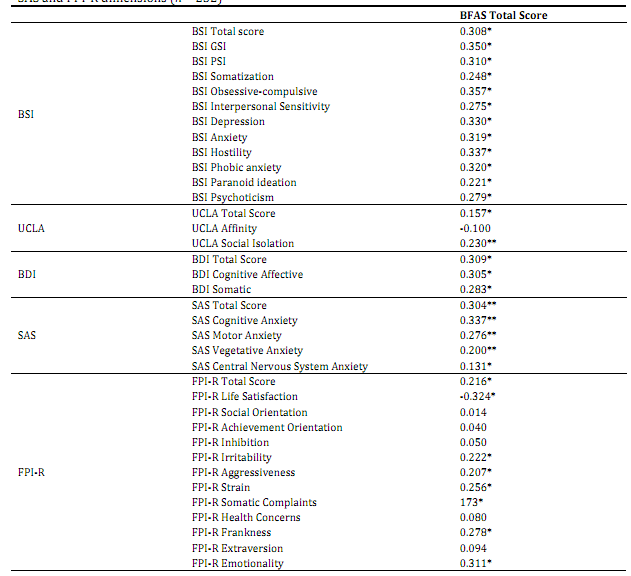
Note: *p < 0.05, **p < 0.01
The results show that there are significant positive correlations for p < 0.01 between the total score of BFAS and all dimensions of BSI, with 0.221 < rsp < 0.357. Positive correlations are also observed with the indices GSI (rsp = 0.350, p < 0.01) and PSI (rsp = 0.310, p < 0.01), where GSI is the Global Severity Index and PSI is the Positive Symptom Index. There are also positive and significant correlations between the total score of BFAS and the total score of BSI for p < 0.01, with rsp = 0.308.
The results also show that there is a positive and significant correlation between the total score of BFAS and a dimension - social isolation - of the UCLA Loneliness Scale (rsp = 0.230, p < 0.01). A positive and significant correlation also exists between the total score of BFAS and the total score of UCLA Loneliness Scale (rsp = 0.157, p < 0.05).
Positive and significant correlations between the total score of BFAS and all dimensions of SAS, except for the anxiety of the central nervous system, for p < 0.01, with 0.200 < rsp < 0.337, can also be found. A positive and significant correlation also exists between the total score of BFAS and the anxiety of the central nervous system SAS subscale (rsp = 0.131, p < 0.05).
Finally, positive and significant correlations are found between the total score of BFAS and the total score of FPI-R (rsp = 0.216, p < 0.01): and also several FPI-R dimensions: the dimension strain (rsp = 0.256, p < 0.01), the dimension aggressiveness (rsp = 0.207, p < 0.01), the dimension excitability (rsp = 0.222, p < 0.01), the dimension somatic complaints (rsp = 0.173, p < 0.01), the dimension frankness (rsp = 0.278, p < 0.01) and the dimension emotionality (rsp = 0.311, p < 0.01). A negative and significant correlation exists between the total score of BFAS and the dimension life satisfaction (rsp = -0.324, p < 0.01).
Discussion
The main aim of the present study was to adapt the BFAS for a sample of the Portuguese population. Our hypothesis (it was expected that the validation of this instrument with 18 items for the Portuguese population would present a good fit) was not confirmed. The confirmatory factor analysis of the original unifactorial BFAS structure indicated that the original BFAS model (Figure 1: Model 0) proposed by Andreassen and colleagues (2012) has a mediocre fit to the sample under study. The refinement of the model was accomplished based on the MI and also considering theoretical support (Marôco, 2010). The modified BFAS model (a second-order model with 10 items and 4 factors) (Figure 5: Model 4) presents goodness-of-fit indices which indicate a good overall fit. Regarding the parsimony of the final modified BFAS model, it appears that the new model reveals statistics indicating a more parsimonious model than the original BFAS model. The new model suggests that addiction to FB is primarily related to salience, tolerance, mood modification and withdrawal. Relapse and conflict factors, proposed by the author of the original scale along with the other above-mentioned factors, have no expressiveness in terms of FB addiction between Portuguese users. While the original version of BFAS (Andreassen et al., 2012) presents a unifactorial structure of 18 items, the final modified BFAS Portuguese version has a multifactorial structure of 10 items and 4 factors. It is, however, difficult to make comparisons between the Portuguese version of BFAS and the original version of BFAS, since statistical analyses were not overall the same.
Regarding the reliability of the construct, it is greater than the reference value for all factors (Marôco, 2010). According to the reference values of Hair et al. (2009), the modified model of the Portuguese version of BFAS presents a high reliability for the sample under study. In respect to the construct validity, the AVE values confirm the strong convergent validity of the factors under study (Fornell & Larcker, 1981). In terms of the convergent validity carried out with the BSI, the UCLA Loneliness Scale, the BDI, the SAS and the FPI-R, the results show that this instrument relates to other constructs (psychopathological symptomatology, loneliness, depression, anxiety and personality) in a manner that is consistent with the theoretical predictions about the FB addiction construct (Andreassen & Pallesen, 2014;Andreassen et al., 2012; Becker et al., 2013; Feinstein et al., 2012; Garcia & Sikström, 2014; Jelenchick et al., 2013; Kim et al., 2009; Nitzan et al., 2011; Ryan & Xenos, 2011; Tran, 2012).
In fact, the higher the values found in BFAS, the higher the values of the psychopathology, namely the total BSI and its indexes (GSI and PSI). This also applies to the values of its somatization, obsession-compulsion, interpersonal sensitivity, depression, anxiety, hostility, phobic anxiety, paranoid ideation and psychoticism dimensions. The same happens with loneliness, mainly with one of the dimensions of the UCLA Loneliness Scale - social isolation - as well as with depression, and, more specifically, with its cognitive affective and somatic dimensions. It is also important to state that the higher the value of FB addiction, the higher the value of anxiety and its dimensions: cognitive anxiety, motor anxiety, vegetative anxiety and central nervous system anxiety. The same happens with some personality dimensions: excitability, aggressiveness, strain, somatic complains, frankness and emotionality. In contrast, the higher the value of FB addiction, the lower the value of the FPI-R dimension, life satisfaction. This suggests that psychological well-being diminishes as FB addiction increases.
Differences found between the BFAS authors’ model and that presented in this paper can still be interpreted in the light of some differences relating to the sample: the sample of the BFAS authors included 423 students with a mean age of 22 years; our sample consisted of 232 subjects with an average age of 30 years. Eventually, the factors salience, tolerance, mood modification and withdrawal are the ones that best explain FB addition in an older population - the Portuguese population. The factors that are present in the original model and which are not present in the presented model are relapse and conflict, as already indicated. The conflict factor may actually have a more significant expression in a younger population than in an older one - the Portuguese -, which helps to explain its absence in the presented model. The relapse factor may be related to culturally specific characteristics of the authors’ sample.
Concluding, in the present study, the modified BFAS second-order model acquires a different factor structure of the original BFAS, despite maintaining 4 of the main theoretical elements and 10 of the 18 original items. A smaller scale has practical implications in terms of being an advantage in research studies. The results indicate that the final Portuguese BFAS version presents good psychometric qualities in the sample under study, indicating a large potential in the evaluation of FB addiction, as well as regarding the associations between this scale of measurement and other theoretically related constructs (psychopathological symptomatology, loneliness, depression, anxiety and personality), which may have implications in the design of more effective psychological intervention programs. This study supports the validity and reliability of this modified BFAS in the sample of 232 respondents under study. In the future, it would be interesting and necessary to expand the use of this scale in other samples of the Portuguese population, for further validation of results.














